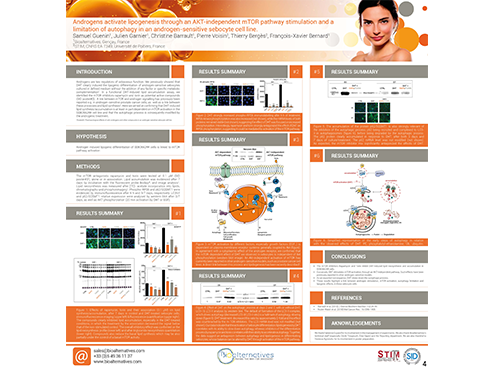
Androgens activate lipogenesis through an AKT-independent mTOR pathway stimulation and a limitation of autophagy in an androgen-sensitive sebocyte cell line.
Acne, Peau grasse, hyperséborrhée et séborégulation, Sebaceous gland regulationAndrogens are key regulators of sebaceous function... A link between mTOR and androgen signaling has previously been reported...as well as a link between these processes and lipid synthesis...Here we aimed at confirming that DHT-induced lipid synthesis/accumulation is at least in part dependent on mTOR activation in the SEBO662AR cell line and that the autophagic process is consequently modified by the androgenic treatment.

Pollution and epigenetics: Histone H3 modifications in keratinocytes after exposure to urban dust and Benzo(a)pyrene
Cosmetics_cat_publi, Skin protection and immune defense systemIn this work, human epidermal keratinocytes were used to study the effects of urban dust and benzo(a)pyrene on the epigenetic pattern of the histone H3 protein. The assay was then used to screen a series of plant extracts in order to find cosmetic actives to protect the skin against air pollution.
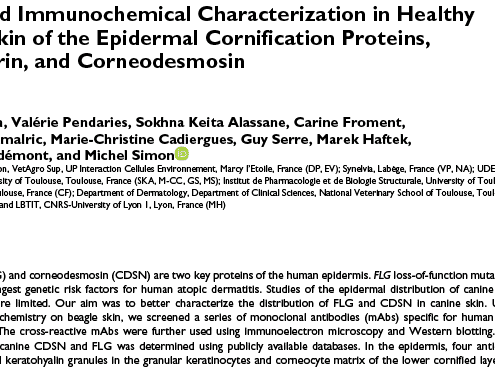
Refined Immunochemical Characterization in Healthy Dog Skin of the Epidermal Cornification Proteins, Filaggrin, and Corneodesmosin
Barrière cutanée et hydratation, Skin barrier and hydration, Veterinary Medicine, Veterinary medicineFilaggrin (FLG) and corneodesmosin (CDSN) are two key proteins of the human epidermis.

The Actin-Based Motor Myosin Vb Is Crucial to Maintain Epidermal Barrier Integrity
Cosmetics_cat_publi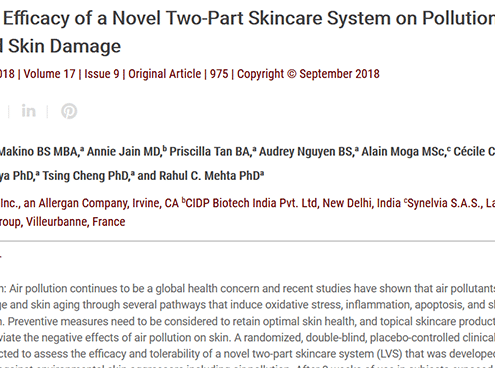
Clinical Efficacy of a Novel Two-Part Skincare System on Pollution-Induced Skin Damage
Cosmetics_cat_publiAir pollution continues to be a global health concern and recent studies have shown that air pollutants can cause skin damage and skin aging through several pathways that induce oxidative stress, inflammation, apoptosis, and skin barrier dysfunction.
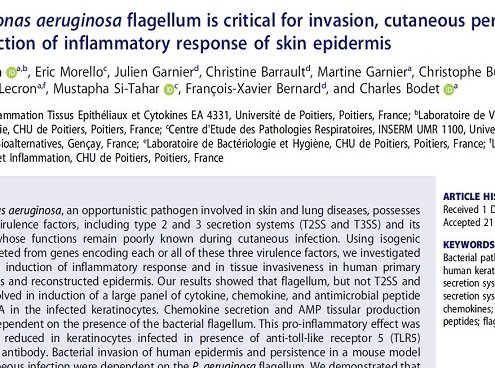
Pseudomonas aeruginosa flagellum is critical for invasion, cutaneous persistence and induction of inflammatory response of skin epidermis
Cosmétique, Microbiome cutané, Skin microbiomePseudomonas aeruginosa, an opportunistic pathogen involved in skin and lung diseases, possesses numerous virulence factors, including type 2 and 3 secretion systems (T2SS and T3SS) and its flagellum, whose functions remain poorly known during cutaneous infection.
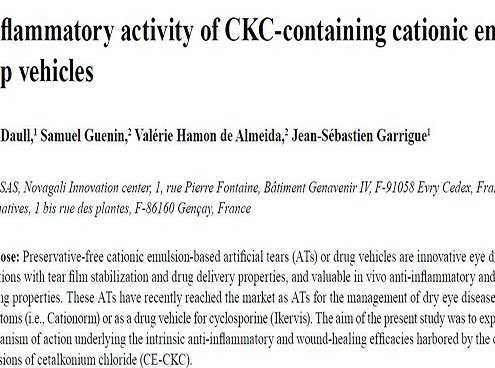
Anti-inflammatory activity of CKC-containing cationic emulsion eye drop vehicles
Cosmetics_cat_publi, Inflammation, PharmacologyPreservative-free cationic emulsion-based artificial tears (ATs) or drug vehicles are innovative eye drop formulations with tear film stabilization and drug delivery properties, and valuable in vivo anti-inflammatory and wound healing properties.
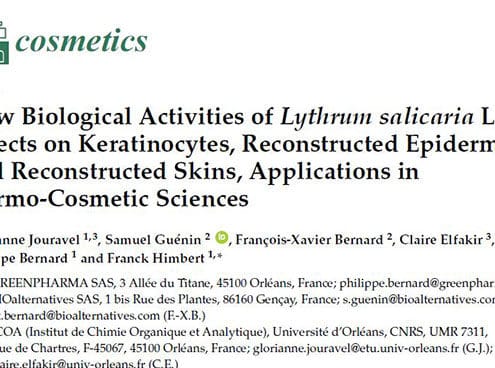
New Biological Activities of Lythrum salicaria L.
Cosmetics_cat_publi, Skin barrier and hydrationThe perennial and widespread herb Lythrum salicaria L., also called purple loosestrife, is a plant that is traditionally used in European medicine.
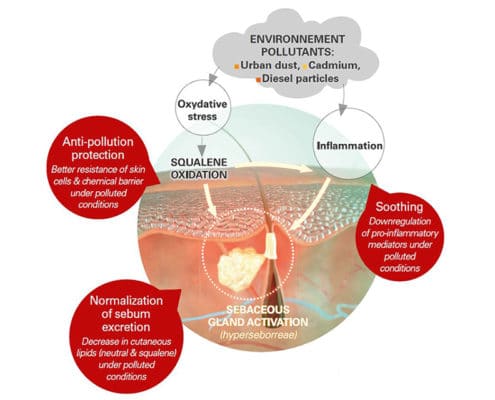
Effects of different kinds of pollutants on the lipidic metabolism of human sebocytes and protective effects of a new macroalgae culture extract
Cosmetics_cat_publi, Peau grasse, hyperséborrhée et séborégulation, Sebaceous gland regulation, Skin protection and immune defense systemSebocytes lipid production are stimulated by pollutants. Ame acts by protecting epidermal cells, human sebocytes and skin from urban dust.
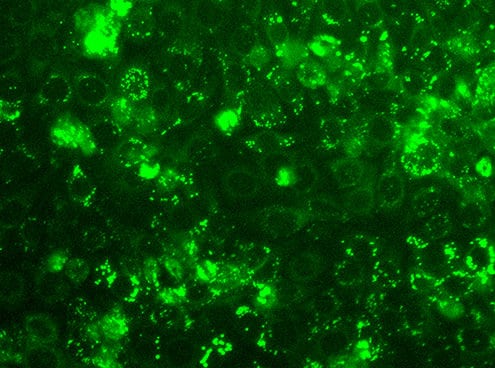
Acne vulgaris: physiopathology and cell mechanisms
Acne, Sebaceous gland regulationAcne Vulgaris is a chronic inflammatory pathology located in the region of the pilosebaceous follicle. It occurs following a high production of sebum linked to hormonal (androgynous) or environmental (pollution) malfunctioning and to the colonization of the pilosebaceous follicle by certain bacteria (P. acnes).
QIMA Life Sciences has developed a panel of innovative assays to discover and evaluate compounds for the treatment of acne.
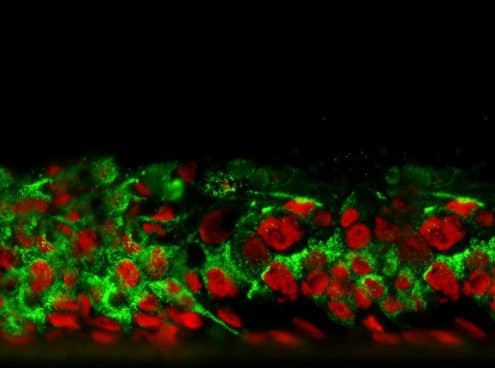
Physiology and functions of the sebaceous gland
Acne, Sebaceous gland regulation, Skin barrier and hydrationThe sebaceous gland is an organ located in the dermis. Its role is to synthesise and secrete sebum which is a component of the hydrolipidic film. The purpose of sebum is to protect the skin from external aggression and dehydration. Sebum also maintains the suppleness of the skin and hair.
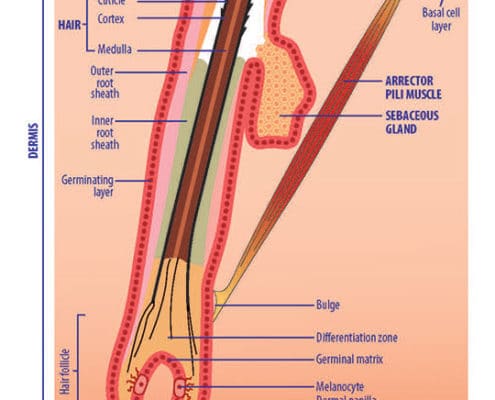
Hair: Follicle, Associated Structures and Growth
Cosmetics_cat_publi, Hair follicleHair follicles are skin adnexa which are able to regenerate in a complete, autonomous, cyclic and asynchronous manner. The histological analysis of the pilosebaceous unit reveals a three-element organization: the epithelial compartment, the mesenchymal compartment and the sebaceous gland.
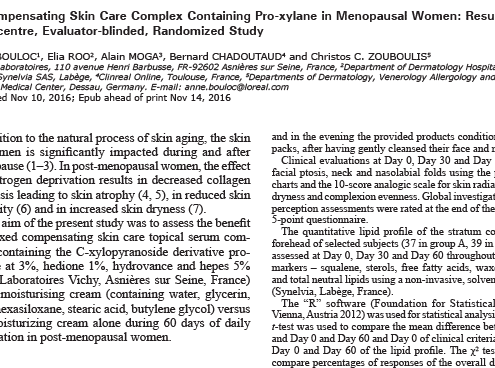
A Compensating Skin Care Complex Containing Pro-xylane in Menopausal Women: Results from a Multicentre, Evaluator-blinded, Randomized Study
Cosmetics_cat_publiIn addition to the natural process of skin aging, the skin of women is significantly impacted during and after menopause.
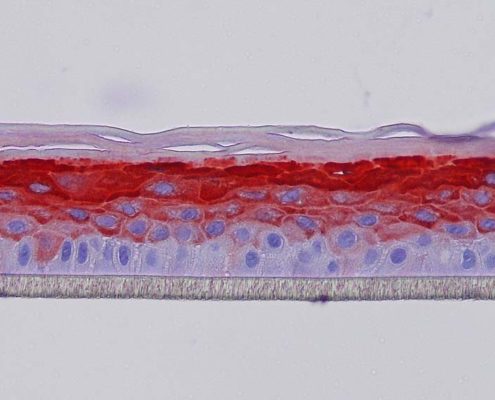
New biological effects of Aphloïol
Cosmetics_cat_publi, Cosmétique, Skin barrier and hydrationIn the present study, we identified new properties of Aphloïol (syn. mangiferin) in improving skin barrier function, especially by promoting keratinocyte differentiation, synthesis of transmembrane glycoprotein and lipid neosynthesis.
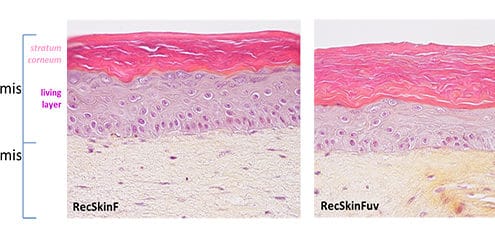
in vitro modeling of skin photoaging: development of evaluation tools for cosmetics
Cosmetics_cat_publi, Skin ageingDevelopment of in vitro models skin for better understand the modifications during photo-aging induced by repetitive UV exposure.
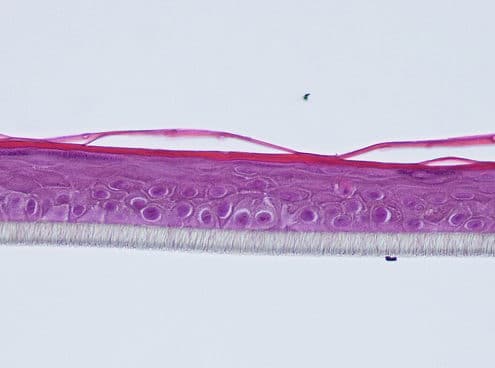
Development of a new model of reconstructed aged skin useful to study antiageing effects of cosmetic compounds
Cell and tissue engineering, Skin ageingThe development of new anti-ageing products needs performant in vitro models mimicking morphological changes and physiological modifications appearing during skin ageing. In order to have access to a simple model mimicking the epidermis ageing but in relation with a normal dermis, we have developed a new in vitro model of reconstructed skin comprising an aged epidermis covering a reconstructed dermis built with collagen and normal (young) fibroblasts.
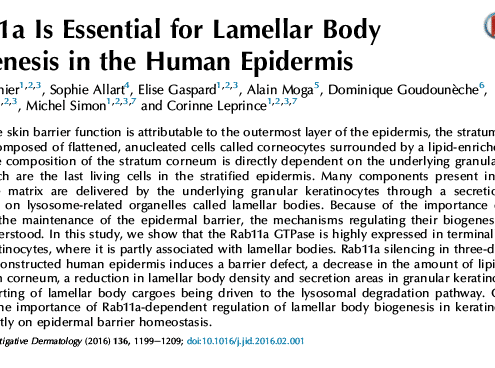
Rab11a Is Essential for Lamellar Body Biogenesis in the Human
Barrière cutanée et hydratation, Skin barrier and hydrationMost of the skin barrier function is attributable to the outermost layer of the epidermis, the stratum corneum, which is composed of flattened, anucleated cells called corneocytes surrounded by a lipid-enriched lamellar matrix.
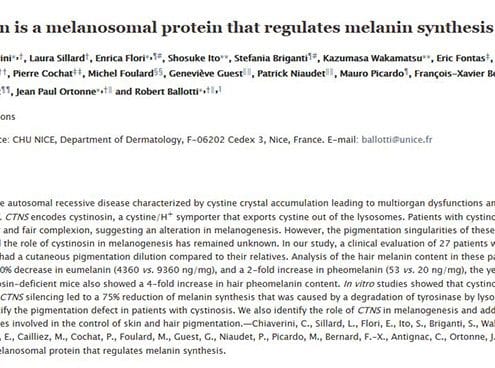
Cystinosin is a melanosomal protein that regulates melanin synthesis
PigmentationIn vitro studies showed that cystinosin was located at melanosomes. CTNS silencing led to a 75% reduction of melanin synthesis that was caused by a degradation of tyrosinase by lysosomal proteases. Our results objectify the pigmentation defect in patients with cystinosis. We also identify the role of CTNS in melanogenesis and add a new gene to the list of the genes involved in the control of skin and hair pigmentation.
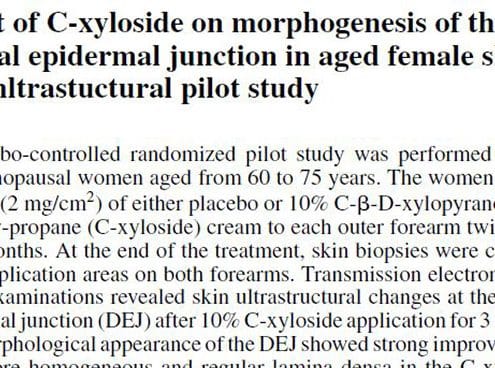
Effect of C-xyloside on morphogenesis of the dermal epidermal junction in aged female skin. An ultrastuctural pilot study
Cosmetics_cat_publi, Cosmétique, Skin ageingThese data suggest that topical C-xyloside application in vivo may be efficient in inducing a better dermal-epidermal cohesion when such a junction is deficient, as is the case in photo-aged or chronologically aged skin. Moreover, a statistically significant increase in CD44 expression was noted in the epidermis of C-xyloside-treated compared to the placebo treated skin areas.
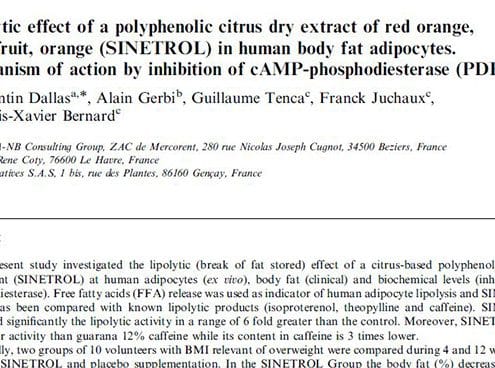
Lipolytic effect of a polyphenolic citrus dry extract of red orange, grapefruit, orange (Sinetrol) in human body fat adipocytes. Mechanism of action by inhibition of cAMP-Phosphodiesterase (PDE)
Cosmetics_cat_publi, CosmétiqueThe present study investigated the lipolytic (break of fat stored) effect of a citrus-based polyphenolic dietary supplement (SINETROL) at human adipocytes (ex vivo), body fat (clinical) and biochemical levels (inhibition of phosphodiesterase).


